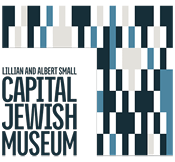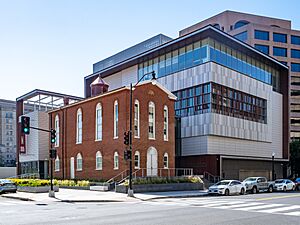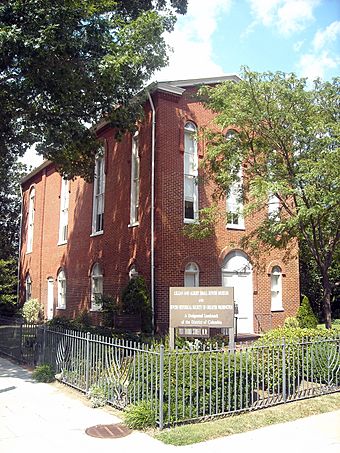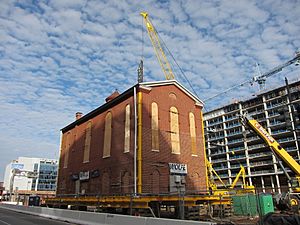- This page was last modified on 17 October 2025, at 10:18. Suggest an edit.
Lillian & Albert Small Capital Jewish Museum facts for kids
 |
|
 |
|
| Lua error in Module:Location_map at line 420: attempt to index field 'wikibase' (a nil value). | |
| Former name |
|
|---|---|
| Established |
|
| Location | 575 3rd Street NW, Washington, D.C. 20008 |
| Type |
|
|
Adas Israel Synagogue (original)
|
|

Adas Israel Synagogue in 2008
|
|
| Built | 1876 |
| Architect | Max Kleinman; J. William & Co. |
| NRHP reference No. | 69000288 |
| Significant dates | |
| Added to NRHP | March 24, 1969 |
The Capital Jewish Museum, also known as the Lillian & Albert Small Capital Jewish Museum, is a special place in Washington, D.C.. It's a museum and a historical society that teaches about the history of Jewish people living in the American capital city and the areas around it.
This organization used to be called the Jewish Historical Society of Greater Washington (JHSGW). In 2018, they changed their name as they got ready to open their new museum. The group started in 1960 and became a nonprofit organization in 1965. From 1975 to 2016, they had a museum inside the old Adas Israel Synagogue building. This synagogue was built in 1876 and is the oldest one still standing in the city. The synagogue building has been moved three times! Its final move in 2019 made it a part of the new Capital Jewish Museum.
Contents
Discover the Capital Jewish Museum
The Capital Jewish Museum opened its doors in 2023. It's a large building, about 32,500 square feet, located in the Judiciary Square and Capitol Crossing area of Northwest Washington. The museum has four floors, with three floors dedicated to exhibits and special programs. A very important part of the museum is the historic synagogue, which has been carefully restored to look just as it did originally.
The museum calls the old synagogue its "centerpiece" and even its "largest artifact." This means it's the most important item in their collection! The museum also has many other cool things. These include a lace collar worn by U.S. Supreme Court Justice Ruth Bader Ginsburg and a notebook used by Justice Louis Brandeis. You can also see old photos of Jewish life in Washington, like a 1925 picture of President Calvin Coolidge at a Jewish Community Center. There's a banner carried by Jewish lobbyist Hyman Bookbinder at the 1963 March on Washington for Jobs and Freedom. You might also see a kippah (a small cap) from a White House Hanukkah celebration. Plus, there are items from local Jewish businesses and families, like an old bookstore sign and a wedding cup.
The Historic Adas Israel Synagogue
The historic Adas Israel Synagogue was built in 1876. It was first located at 6th and G Streets, Northwest, and was home to the Adas Israel Congregation. A very special event happened on June 9, 1876: U.S. President Ulysses S. Grant attended the synagogue's dedication. This was the first time a sitting president went to a Jewish service. This building is the oldest synagogue building still standing in Washington, D.C..
Over the years, many immigrants from Eastern Europe and Russia came to the area, and the congregation grew much larger. The congregation used this original synagogue until 1908. Then, they moved to a new building at Sixth and I Streets, NW. That building is now known as the Sixth & I Historic Synagogue.
After the congregation moved, the original 1876 building was sold to Stephen Gatti, an Italian-American businessman. In the 1910s, Saint Sophia's Greek Orthodox Church used the second-floor sanctuary. Other churches also used the building from the 1920s to the 1940s. For about 60 years, the first floor of the old synagogue was divided into small shops. It housed a bicycle shop, a barber, a grocery store, a delicatessen, and other businesses.
In the 1960s, there were plans to build the Washington Metropolitan Area Transit Authority headquarters. This project would have meant tearing down the old synagogue building. But with help from federal and city groups, the Jewish Historical Society of Greater Washington arranged to move the building. It was moved three city blocks to Third and G Streets, NW. On September 1, 1969, President Richard Nixon signed a law that allowed the District of Columbia government to buy the building. They then leased it to the Society for just $1 a year for 99 years, so it could be preserved as a historic site.
The Jewish Historical Society of Greater Washington restored the historic synagogue building. In 1975, it became the home of the Lillian & Albert Small Jewish Museum.
The historic synagogue building is very important. It is listed on the National Register of Historic Places, which means it's recognized as a significant historical site. It's also on the District of Columbia Inventory of Historic Sites and is part of the Historic American Buildings Survey. It is one of the oldest synagogue buildings still standing in the United States. It is also an official project of the Save America's Treasures program, which helps protect important American landmarks.
Moving the Synagogue to its New Home (2016–2021)
Starting in 2016, the area where the synagogue sat was needed for a new building project called Capitol Crossing. This meant the synagogue had to move again because the land it was on was sold. So, the museum closed its doors so the building could be moved to a new, permanent home. This new home would be part of a brand new museum building built around the historic synagogue.
The move happened in two steps. First, the building was moved about 50 feet to a temporary spot on Third Street NW. It waited there while a parking garage, which would be its permanent base, was built. Then, in early 2019, the building made its final move to the corner of Third and F Streets, NW. Local leaders came to watch the move and give speeches, and a rabbi said a special prayer. In its new spot, the synagogue now faces east, which is important in Jewish tradition. It is now a key part of the Capital Jewish Museum.

